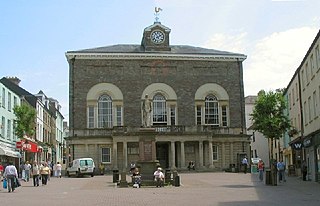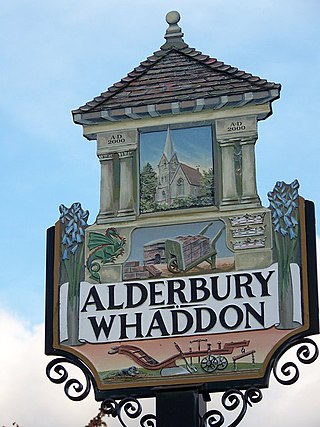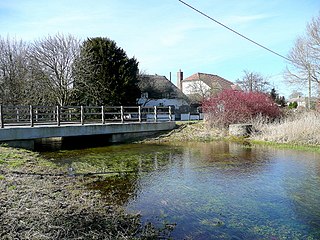
Sir Robert Taylor (1714–1788) was an English architect and sculptor who worked in London and the south of England.

Chilton Foliat is a village and civil parish on the River Kennet in Wiltshire, England. The parish is in the North Wessex Downs Area of Outstanding Natural Beauty. It is on the county boundary with West Berkshire and is about 1.5 miles (2.4 km) northwest of the Berkshire market town of Hungerford.

Everleigh, pronounced and also sometimes spelt Everley, is a village and civil parish in east Wiltshire, England, about 4+1⁄2 miles (7 km) southeast of the town of Pewsey, towards the northeast of Salisbury Plain.

Winterslow is a civil parish with a population of around 2,000, about 6 miles (10 km) northeast of Salisbury in Wiltshire, England, and lying south of the A30 London Road. It is sited on the Roman road between Old Sarum and Winchester.

Heytesbury is a village and a civil parish in Wiltshire, England. The village lies on the north bank of the Wylye, about 3+1⁄2 miles (5.6 km) southeast of the town of Warminster.

Dinton is a village, civil parish and former manor in Wiltshire, England, in the Nadder valley on the B3089 road about 8 miles (13 km) west of Salisbury. The parish population was 696 at the 2011 census, estimated at 733 in 2019. The civil parish includes the village of Baverstock, about 1 mile (1.6 km) east of Dinton village.

Clarendon Palace is a medieval ruin 2+1⁄4 miles (3.6 km) east of Salisbury in Wiltshire, England. The palace was a royal residence during the Middle Ages, and was the location of the Assize of Clarendon which developed the Constitutions of Clarendon. It now lies within the grounds of Clarendon Park.

Chitterne is a village and civil parish in the county of Wiltshire, in the south west of England. The village lies in the middle of Salisbury Plain, about 7 miles (11 km) east of the town of Warminster.

Horningsham is a small village and civil parish in Wiltshire, England, on the county border with Somerset. The village lies about 4 miles (6 km) southwest of the town of Warminster and 4+1⁄2 miles (7 km) southeast of Frome, Somerset.

Charles Nicholas Paul Phipps, of Chalcot House, near Westbury, Wiltshire, was a merchant trading with Brazil, who sat as Conservative MP for Westbury (1880–1885) and was High Sheriff of Wiltshire (1888).
The Hervey-Bathurst Baronetcy, of Lainston in the County of Southampton, is a title in the Baronetage of the United Kingdom. It was created on 7 December 1818 for Felton Hervey-Bathurst, with remainder, failing heirs male of his own, to the heirs male of his father. Hervey-Bathurst was the grandson of the Hon. Felton Hervey, seventh son of John Hervey, 1st Earl of Bristol, and served as an Aide-de-Camp to the Duke of Wellington after the Battle of Waterloo. Born Felton Hervey, he had assumed by Royal licence the additional surname of Bathurst in 1801. He was succeeded according to the special remainder by his next brother, the second Baronet. The fourth Baronet sat as Conservative Member of Parliament for Wiltshire South. The fifth Baronet was a Major in the Grenadier Guards and fought in the Egypt campaign of 1898, in the Second Boer War and in the First World War, where he was awarded the Distinguished Service Order. As of 2017, the baronetcy is held by the 8th baronet, who succeeded in 2011. As a male-line descendant of the first Earl of Bristol, he is also in remainder to this peerage, which is currently held by his kinsman the Marquess of Bristol.

Alderbury is a village and civil parish in Wiltshire, England, in the south of the county around 3 miles (5 km) southeast of Salisbury.
Lionel Hervey-Bathurst was an English first-class cricketer and British Army officer.
Sir Frederick Thomas Arthur Hervey-Bathurst, 4th Baronet was an English cricketer. Hervey-Bathurst bowled fast roundarm and slow underarm. Hervey-Bathurst was also a Conservative politician.

Sir Frederick Hutchison Hervey-Bathurst, 3rd Baronet was an English cricketer who played for Hampshire, MCC and the Gentlemen of England. He was a right-handed batsman who bowled right-arm roundarm fast.

Newton Tony is a rural English village and civil parish in the county of Wiltshire, close to the border with Hampshire. Situated in the Bourne Valley, Newton Tony is about 9 miles (14 km) north-east of its post town, Salisbury. Wilbury House, a Grade I listed 17th-century mansion, stands in parkland in the north of the parish.

Wilsford cum Lake is a civil parish in the Woodford valley in Wiltshire, England. The parish is bounded to the east by the Salisbury Avon and contains the small settlements of Wilsford, Normanton and Lake. Wilsford is about 2 miles (3.2 km) southwest of Amesbury and 6 miles (10 km) north of Salisbury.

Tedworth House, also known as South Tidworth House, is a 19th-century country house in Tidworth, Wiltshire, England. It is a Grade II* listed building and is used by the charity Help for Heroes.
Wilbury House or Wilbury Park is an 18th-century Neo-Palladian country house in the parish of Newton Tony, Wiltshire in South West England, about 8.7 miles (14 km) northeast of Salisbury. It is a Grade I listed building, and the surrounding park and garden are Grade II listed.

The Church of St. Thomas à Becket is the Church of England parish church of Box, Wiltshire, in south-west England. It is one of a number of churches named after Thomas Becket following his martyrdom. The church has 12th-century origins and was substantially remodelled in the 14th, 15th, 18th and 19th centuries. It is a Grade I listed building.
















